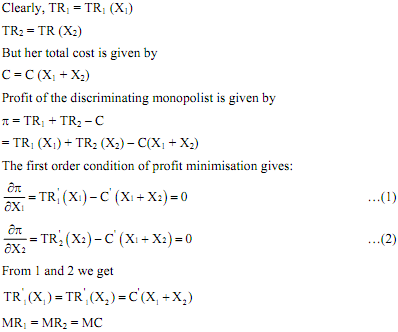Equilibrium of a Discriminating Monopolist:
Let us consider a monopolist who sells her output at two different markets.
Let X1 be the amount of output sold in the 1st market and X2 is the amount of output sold in the 2nd market. Therefore, the total amount sold by the monopolist is (X1 + X2)
Let TR1 and TR2 are the total revenues obtained from the two markets.

Hence, the condition of profit maximisation for a discriminating monopolist is given by marginal revenue in 1st market = marginal revenue in 2nd market= marginal cost If MR1 > MR2 , it is profitable for the monopolist to sell more in 1st market and this continues till MR1 = MR2. Therefore, at equilibrium MR1 = MR2 = MC The equality of marginal revenues does not mean the equality of prices in the two markets as long as the price elasticity of demand is different in the both
markets.
The second order condition requires that the principal minors of the Hessian determinant,

alternate in sign beginning with the negative sign. This requires

The equilibrium of a discriminating monopolist can be explained with the help of the following diagram.

In the first two panels of the diagram, we have drawn the MR curves of two markets. In the third panel, we obtained the combined MR curves by horizontally summing over MR1 and MR2. The combined MR and MC curves meet at the point E. We have drawn a horizontal line passing through E which cuts MR1 and MR2 at the point E1 and E2. At E1, MR1 = MC and at E2, MR2 = MC. Therefore, the conditions of profit maximisation for a discriminating monopolist is satisfied at E1and E2, Accordingly, the monopolist will sell X1* amount of output in market 1 at price P1* and X2* amount of output in market 2 at price P2*